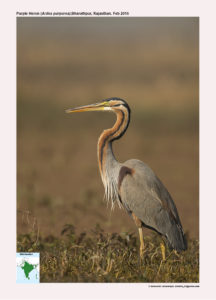Purple Heron

Purple Heron Aredea purpurea
Etymology
- Ardea : Latin word ardea- In Roman mythology the town of Ardea, capital of the Rutuli, was razed to theground, and from the ashes rose a lean, pale bird,shaking the cinders from its wings and utteringmournful cries.
- Purpurea : Latin word for purple-coloured derived from purpur-purple
Vernacular Names: Hindi: Nari, Laal anjan, Laal sain, Sans: Neel bak, Pun: Kirmachi nari, Bi: Khyra, Ben: Laal kank, Ass: Laal kol, Guj: Nadi, Nadi bagalo, Mar: Pavkali bagla, Pankadi bagla, Jambhala Bagla, Ta: Chen-naarai, Te: Yerra narayana pakshi, Mal: Chayamundi, Sinh: Karawala kokka, Barendi kokka.
Distribution in India: Wide spread resident except for Himalayas, Bengal and Rajasthan
Description: Size of 80-90 cm. Adults have the forehead and the crown of the head black, with a dark stripe down the back of the neck that terminates in a slender, dangling crest. The sides of the head and the neck are buffish chestnut, with dark streaks and lines down either side of the whole the neck. The mantle is oily brown and the upper scapular feathers are elongated but not the lower ones. The rest of the upper parts and the tail are brownish grey. The front of the neck is paler than the sides and there are some elongated feathers at the base of the neck which are streaked with white, chestnut and black. The breast is chestnut brown, with some blackening at the side, and the belly and under-tail coverts are black. The brownish-yellow beak is long, straight and powerful, and is brighter in colour in breeding adults. The iris is yellow and the legs are brown at the front and yellowish behind.
Habitat: It is found in freshwater habitats, particularly locations with reed beds marshes, lagoons and lakes surrounded by dense vegetation, also in mangrove swamps on the coast
Food Habits: It eats fish, small mammals and amphibians, nestling birds, snakes, lizards, crustaceans, water snails, insects and spiders . It feeds in shallow water, grabbing its prey with its powerful beak. It will often wait motionless for prey, or slowly stalk its victim.
Breeding Habits: They usually breeds in colonies but sometimes the nests are solitary.They sometimes associates with other species such as the goliath heron (Ardea goliath) or grey heron at multi-species nesting colonies. The site chosen is generally in reed beds, canebrakes or low bushes close to large lakes or other extensive wetlands. It builds a bulky nest of dead reeds, sticks or whatever is available. They lay a clutch of 4-5 eggs. The eggs are laid at intervals of three days. Both parents share the incubation, which lasts between 24 and 28 days, and the care of the young. When an adult brings food, its beak is dragged down by the chicks and it regurgitates food from the crop onto the nest, or the young may take food directly from the beak. The young fledge at about six weeks and become independent at two months. They then disperse widely.